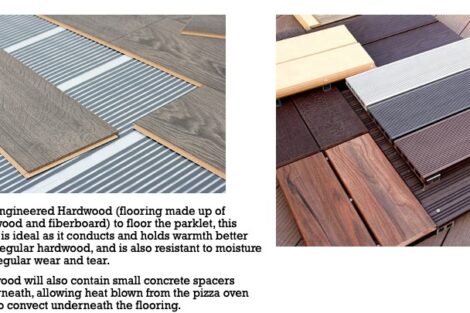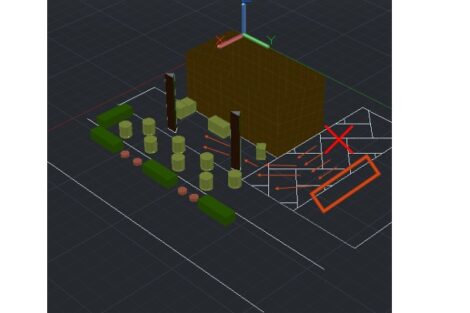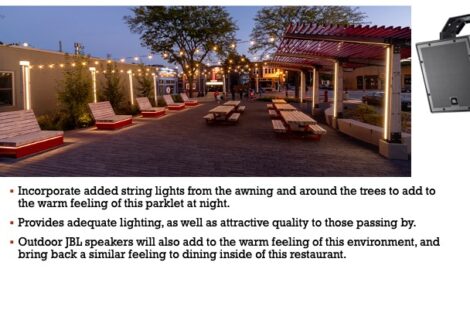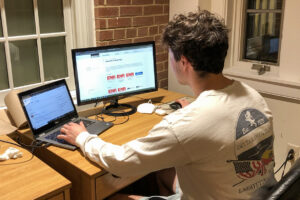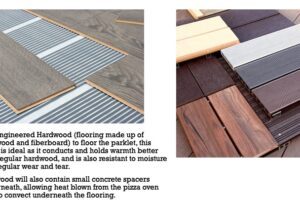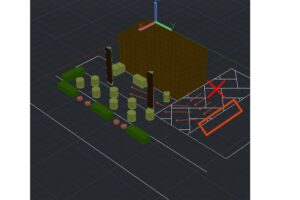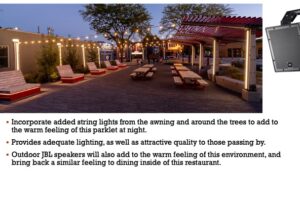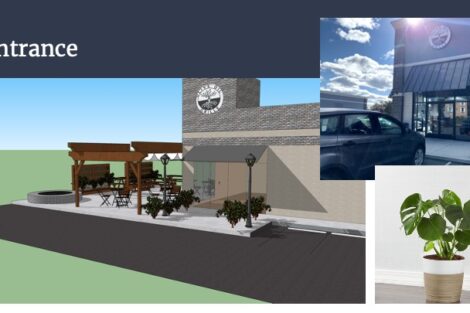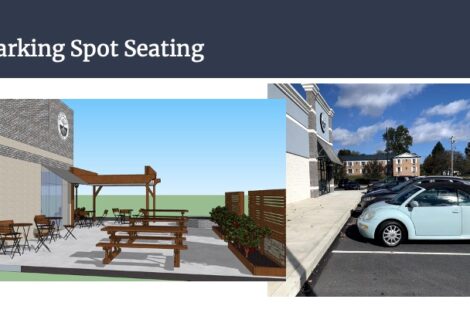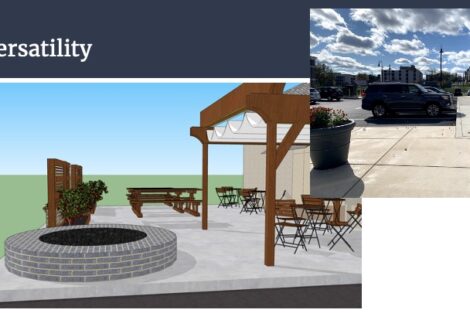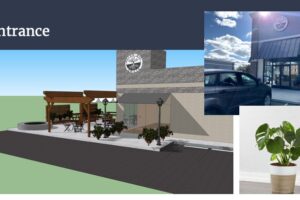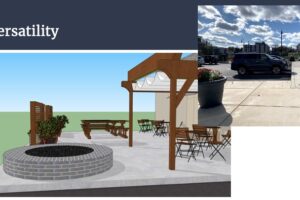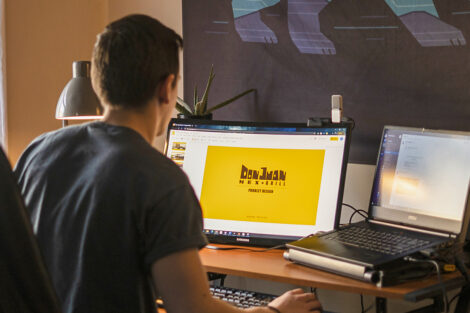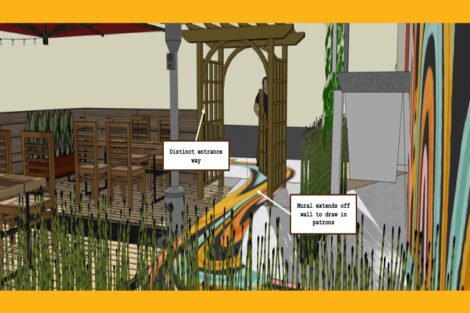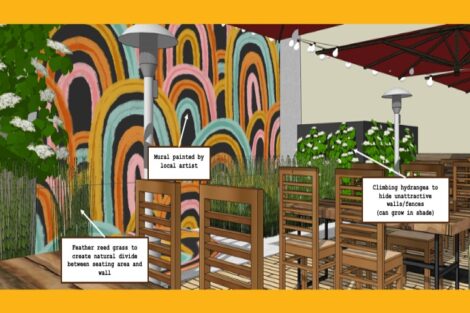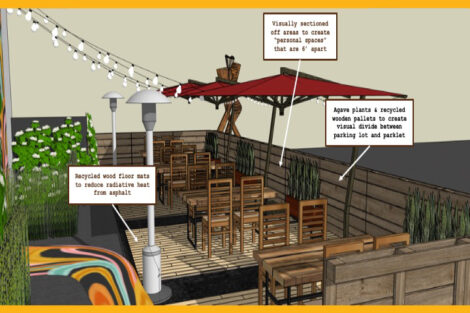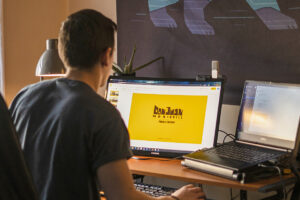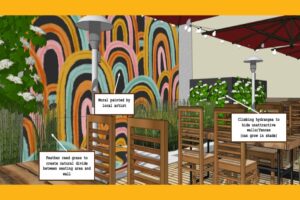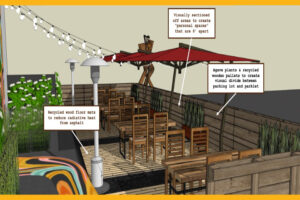Parklets and Pandemics
By Bryan Hay
From a family who operates two restaurants in the Bay Area of San Francisco, Michael Anderson ’21 (mechanical engineering) is well aware of the food service industry’s struggles during the pandemic.
According to the National Restaurant Association’s 2021 State of the Restaurant Industry report, more than 110,000 eating and drinking establishments have closed for business temporarily or permanently due to the economic effects of COVID-19.
To survive amid shutdowns and restricted seating orders, restaurateurs have had to adapt by adjusting menus and staffing, shifting to takeout and delivery service, and offering outdoor dining.
Anderson jumped at the opportunity to enroll in Prof. Mary Wilford-Hunt’s Introduction to Architectural Engineering course (EGRS 271), which last semester tasked some students to produce feasibility studies to transform street parking into an open-air amenity for dining, or parklet.
Using sidewalk and street spaces, parklets have become popular options to help restaurants expand the number of customers they can seat outdoors. Restaurants in Easton and throughout the Lehigh Valley of eastern Pennsylvania and nationwide have turned to al fresco parklets as a way to welcome back customers hungry for a return to some normalcy.
Students had the option to design a parklet for a restaurant of their choosing.
“All of the students who participated did a fine job,” says Wilford-Hunt, senior associate director of corporate, foundation, and government relations, who has been teaching courses in engineering studies for more than a decade.
“One of the reasons I think this was a successful exercise is that it didn’t matter where the students were,” she adds. “Due to the pandemic, some participated from their hometowns, others near or on campus. Everybody was in a similar situation where their favorite eateries were suddenly closed down and forced to very quickly accommodate outdoor dining to increase their capacity in order to survive.”
Anderson’s family experiences in the restaurant business drove his creativity in the class and led to a design for Sette Luna, a Tuscan-style trattoria that serves wood-fired pizza. It’s one of his favorite places to eat in downtown Easton.
His design involved adapting engineered hardwood to the outdoor flooring to allow air to pass beneath, while bringing the pizza oven outdoors. It would create a more intriguing outdoor environment, and use small construction fans to create a convective heat transfer from the pizza oven to the bottom side of the floorboards.
“This ultimately would improve the aura of the eating space and provide heating for customers while dining,” Anderson says.
Although pandemic safety protocols prevented face-to-face meetings with restaurant owners, Anderson and others students in the class hope to eventually share their designs and ideas in person.
Maddie Barto ’22 (mechanical engineering and international studies) produced a parklet design for a restaurant in her hometown of Camp Hill, Pa.
“I really love the food at the local small business I picked in my hometown,” she says. “But I think that the location and lack of seating is stopping them from being the perfect hangout spot for the two or three schools within a few blocks.”
A Chipotle-style restaurant that serves Mediterranean cuisine, her favorite local eatery serves very fast, fresh food. Barto determined that the 24 parking spots on three sides of the building and two entrances were unnecessary.
“I thought the one entrance could become a server entrance, and I proposed that the side of the building be converted to a patio,” she says, noting that the patio would reflect the industrial-themed materials featured in the restaurant’s interior and create a cohesive design. Large permanent planters made of rapidly renewable materials would make the space feel more intimate while still allowing necessary airflow.
“Additionally, I thought a great focal point would be a stove/fire pit, so when it is colder people can still socially distance, and they could potentially cook some of their foods out there to create a full sensory experience for guests,” Barto says.
Combining his interests in creative design with the engineering objectives of the class, Andrew Chilicki ’21 (mechanical engineering and film & media studies) decided to take advantage of Easton’s Karl Stirner Arts Trail and its proximity to Don Juan Mex Grill on N. Third Street.
“Incorporating features such as murals by local artists, as well as bike racks, the design was curated to attract those who may be passing by on the arts trail and looking for a local spot to grab a bite,” he says.
Along with added greenery, recycled wall paneling, sectioned-off seating to adhere to COVID safety guidelines, as well as additional, more casual, seating for those looking to eat more closely to Bushkill Creek, Chilicki’s parklet was designed to transform what was just an asphalt parking lot into a safe, aesthetically pleasing food experience. Passive solar techniques and sustainable stormwater strategies were incorporated as well.
Students and professor found designing the parklets satisfying because by applying sustainable strategies, they brought about creative and practical solutions to help address a challenge that restaurants still face as a result of the public health crisis.
“This concept of parklets is something that I’ve been thinking about for years,” Wilford-Hunt says. “We actually had some students take a look at parklets in past semesters, but it was before the pandemic and not as a singular focus.”
She started working on the syllabus last summer, knowing that coursework in the fall semester would be largely remote. “I wanted to do something that was more hands on and allow students to participate wherever they happen to be,” Wilford-Hunt adds.
“My favorite part of class was the creativity in seeing the elements that we learned in class incorporated into other people’s parklet designs,” Barto says.
Chilicki enjoyed the course because it used his knowledge of engineering projects in tandem with what he learned in the class. “Combined together, it produced a practical application that could potentially have real impacts on the community surrounding Lafayette College,” he says.
For success, the parklet initiative required self-starting students who would recognize a real need and fully embrace the opportunity to deliver professional, tangible results, Wilford-Hunt says.
“This project helped bring to light the struggle that restaurant workers and owners are facing during this pandemic, yet also showed me some amazing things that people have done under these circumstances,” Anderson says.

